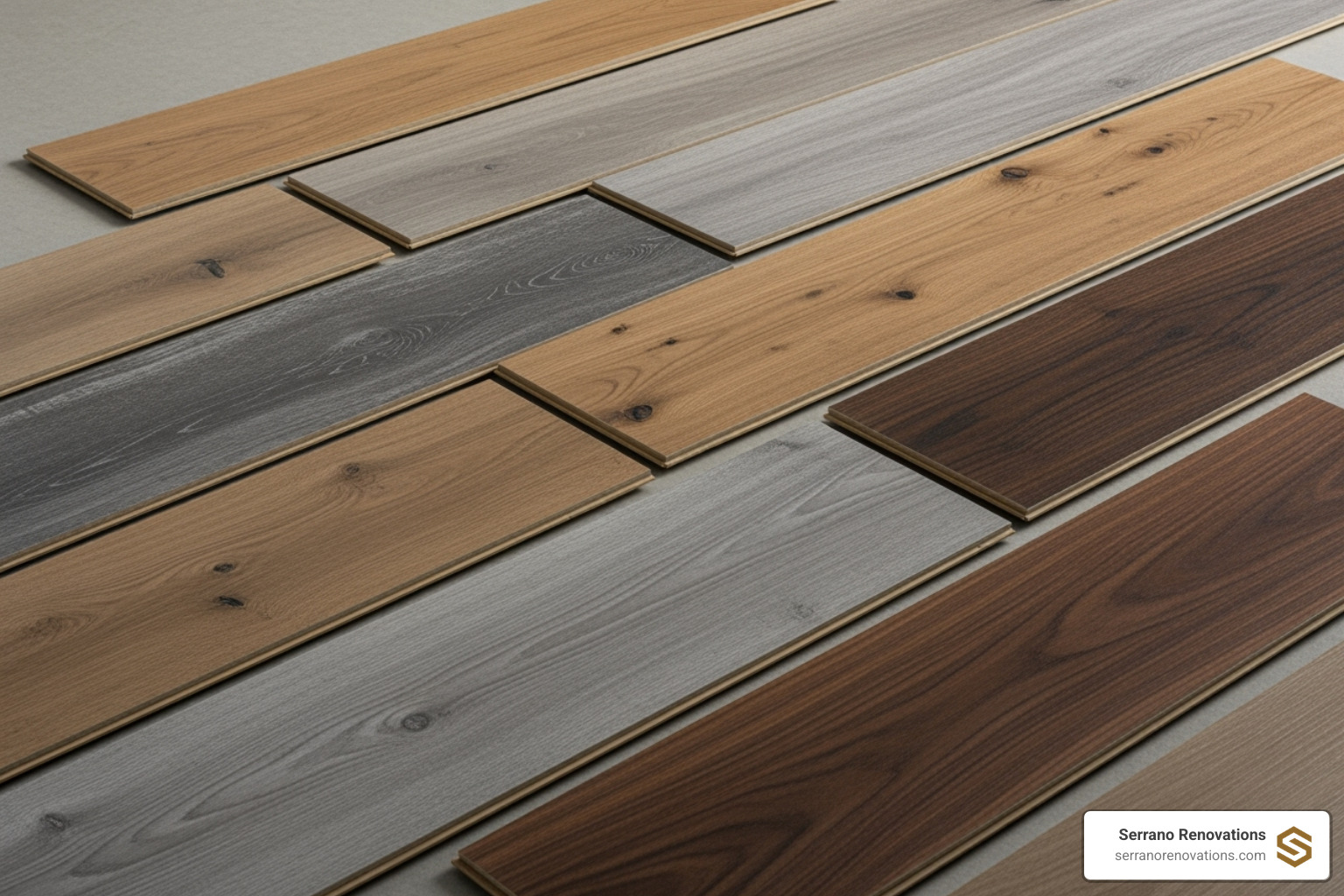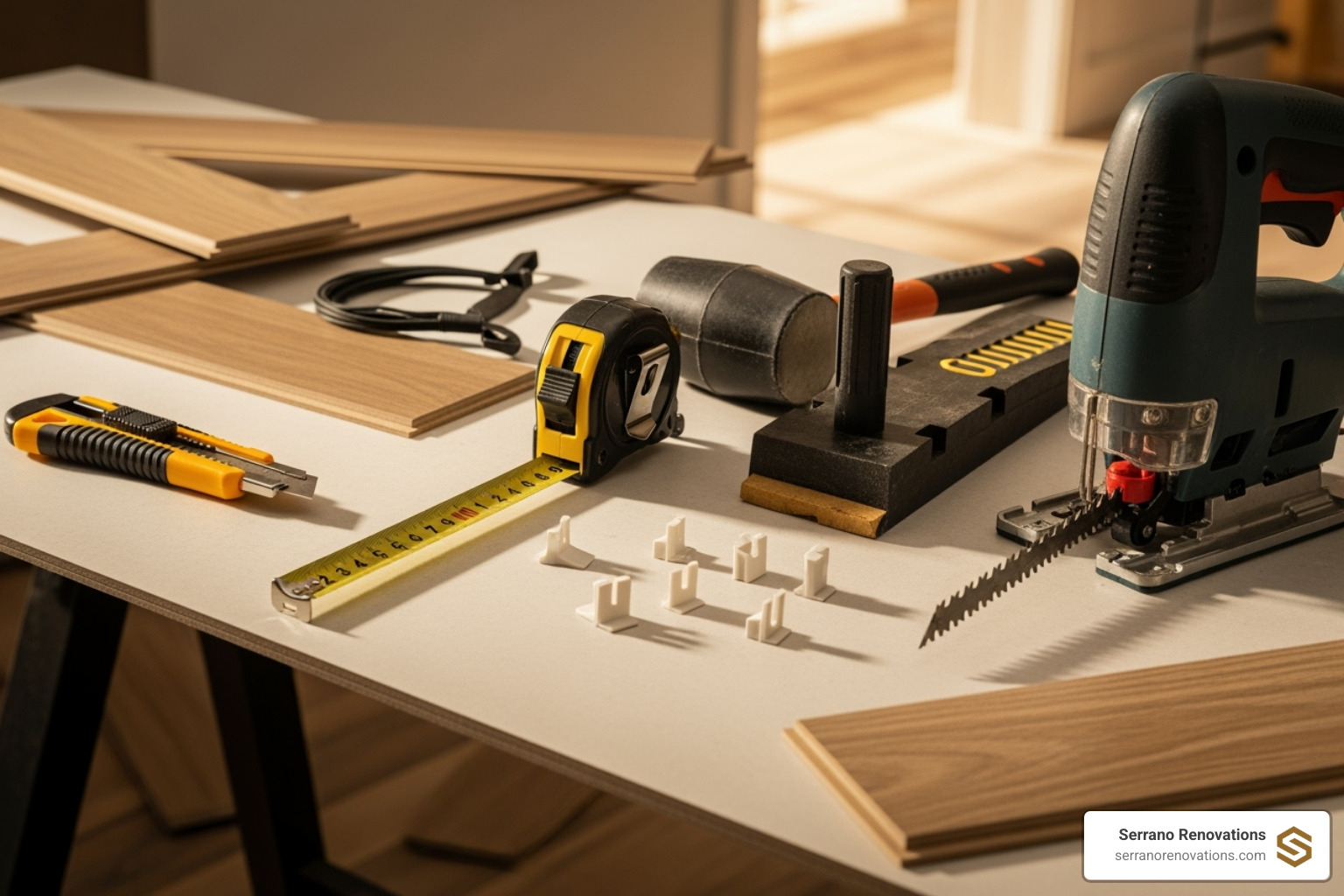Understanding LVP Flooring Installation Costs in 2025
The cost to install LVP flooring typically ranges from $4 to $16 per square foot, including both materials and professional installation. This breaks down to $2-$10 per square foot for materials and $2-$6 per square foot for labor.
Quick Cost Overview:
- Materials: $2-$10 per square foot
- Labor: $2-$6 per square foot
- Total Installed Cost: $4-$16 per square foot
- Average 200 sq ft room: $800-$3,200
- Average 1,000 sq ft home: $4,000-$16,000
Luxury vinyl plank (LVP) flooring is one of the most popular home renovation choices because it offers the beautiful look of hardwood or stone at a fraction of the cost, plus it’s waterproof and incredibly durable.
However, the total project cost depends on more than just the flooring itself. Subfloor preparation, old flooring removal, and installation complexity can add $1-$5 per square foot to your project budget.
Understanding these cost factors upfront helps you plan your budget accurately and avoid surprise expenses, regardless of project size. The key is knowing what influences the price and where you can save without sacrificing quality.

Understanding the Numbers: A Breakdown of LVP Flooring Costs
Let’s break down what you’re paying for when installing LVP flooring. The total cost to install LVP flooring has three main components: materials, labor, and additional prep work. Understanding each piece helps you budget smartly and avoid surprises.
What is the Average Cost of LVP Flooring Materials?
LVP material costs range from $2 to $10 per square foot, a wide range that reflects the quality and features of the product.
Standard LVP costs $2 to $5 per square foot. These floors look great, perform well, and are perfect for most homeowners who want beautiful, budget-friendly flooring.
Premium luxury vinyl plank can cost $6 to $10+ per square foot. With this, you’re paying for more realistic textures, better scratch resistance, and longer warranties.
The wear layer thickness is crucial for your floor’s lifespan. It’s the protective coating that handles daily abuse. A thicker wear layer means your floors stay beautiful longer.
Core material is another factor. SPC (Stone Polymer Composite) offers a rock-solid, stable feel, while WPC (Wood Polymer Composite) provides more comfort underfoot.
Brand influence also affects price. Established manufacturers often provide better warranties, more realistic designs, and advanced features. Investing a little more in material quality usually pays off with floors that last longer and look better over time.

What Are the Typical Labor Costs for LVP Installation?
Professional installation typically runs $2 to $7 per square foot, depending on project complexity and location. While some contractors charge hourly ($150 to $400 per day), most provide a per-square-foot quote for the job.
Professional installation is a worthwhile investment. Proper installation ensures your floor looks great and lasts for years, preventing issues like gaps, buckling, or premature wear.
The installation timeline for LVP is surprisingly quick. Most rooms can be finished in one to two days, though larger or more complex layouts take longer. The click-lock systems used in most LVP make installation much faster than traditional hardwood or tile.
At Serrano Renovations, we pride ourselves on exceptional craftsmanship. Our team knows that proper installation is what transforms good materials into floors you’ll love for decades. For detailed labor statistics, the Labor Wages and Costs: Occupational Employment and Wage Statistics provides helpful industry data.
Want to learn more about what goes into professional installation? Check out our Flooring Installation services page for all the details.
Key Factors That Influence the Total Cost to Install LVP Flooring
Several factors beyond the planks and installation can significantly impact the final cost to install LVP flooring. These are often the costs that catch homeowners by surprise. Knowing what to expect allows you to plan accordingly and avoid unexpected expenses.
Subfloor Preparation and Old Flooring Removal
The condition of your subfloor is critical. LVP flooring, especially click-lock systems, requires a perfectly level, clean, and dry foundation to perform correctly.
Old flooring removal is the first step and typically costs $0.50 to $2.00 per square foot. Removing carpet is on the lower end, while removing glued-down tile or hardwood is more labor-intensive and costly.
Safety is also a consideration. Homes built before the 1980s may have old tiles or adhesives containing asbestos, which requires specialized professional removal. For this reason, we recommend leaving this job to experts.
After removal, subfloor preparation can add another $1 to $3 per square foot to your project. This essential step involves patching holes, grinding high spots, or applying self-leveling compounds to create a smooth surface. A moisture barrier or underlayment may also be needed, especially over concrete or in basements. Proper subfloor preparation is critical for a long-lasting floor. For more technical details, you can check out resources like The HUD PATH Rehab Guide Volume 5.

How Installation Method Impacts the Overall Cost
The installation method directly impacts your timeline and wallet. There are three main approaches:
Click-lock installation is the most popular method. Planks snap together to create a “floating floor” over the subfloor. It’s faster to install, keeping labor costs reasonable at $2 to $5 per square foot, and can often be installed over existing hard-surface flooring, saving on removal costs.
Glue-down installation is the heavy-duty option, where each plank is adhered to the subfloor. This provides maximum stability for high-traffic areas but is more labor-intensive and requires a perfect subfloor. Expect labor costs of $3 to $8 per square foot for this method.
Peel-and-stick options are less common for true LVP. They are the quickest to install but may be less durable over time.
The right method depends on your needs, budget, and your installer’s recommendation.
How Project Size and Location Affect Your Budget
Larger projects often have a lower per-square-foot price because installers can spread fixed costs over more area. Conversely, small projects may incur minimum service fees, making the per-square-foot cost higher.
Geographic location also plays a significant role. In South Florida, where we serve areas like Boca Raton, Delray Beach, and Broward County, labor rates reflect local market conditions. Urban and coastal areas typically have higher labor costs than rural locations.
Here are some estimated total project costs:
- A 100 sq ft bathroom: $400 to $1,600
- A 200 sq ft bedroom: $800 to $3,200
- A 500 sq ft living area: $2,000 to $8,000
- A 1,000 sq ft whole-home project: $4,000 to $16,000
These are general estimates, as every project is unique.
Pro vs. DIY Installation: Where Your Money Really Goes
Many homeowners wonder whether to install LVP flooring themselves or hire a professional. While DIY seems straightforward with user-friendly click-lock systems, there’s a significant difference between simply doing the job and doing it right. Let’s examine where your money goes in each scenario, as the cost to install LVP flooring isn’t just the sticker price.
Calculating the Professional Cost to Install LVP Flooring
While hiring a professional costs more upfront, it often saves you money in the long run. You’re investing in expertise and experience. Professionals handle tricky cuts, work with uneven subfloors, and create seamless transitions efficiently, which means less material waste.
The speed factor is also significant. A professional team can finish a room in one to two days, a job that might take a DIYer an entire weekend or longer.
Most reputable installers offer a workmanship warranty on their labor. If an installation error occurs, they will fix it, providing peace of mind.
Professionals also come with all the proper tools, saving you the cost of renting or buying equipment. When getting quotes, always ask for a detailed estimate that breaks down all costs. This transparency helps you compare contractors and avoid surprises. If you’re looking for reliable professionals, check out our Flooring Contractors Near Me page.
The True Cost of a DIY LVP Project
DIY installation can save you $1 to $5 per square foot in labor costs. On a 1,000 square foot project, that’s a potential savings of $1,000 to $5,000.
However, there are other costs to consider. Tool rental or purchase can add a few hundred dollars to your project. You’ll need a utility knife, tapping block, mallet, spacers, and a saw for intricate cuts.
Material waste is another common issue. DIYers often make more cutting errors, which can add 10-20% to the material bill.
Your time investment is also significant. A job that takes pros a day could stretch into a week for a DIYer.
The biggest risk is improper installation, which can lead to buckling, gaps, or premature wear. This not only looks bad but can also void your product warranty. We’ve seen homeowners have to replace entire floors due to installation mistakes.
Potential mistakes can also affect your home’s value. A professionally installed floor adds value, while a poor DIY job can detract from it.

While DIY offers labor savings, it requires confidence and patience. For a professional finish and warranty protection, hiring experts is often the smarter investment.
How LVP Stacks Up: Cost Comparison with Other Flooring Options Serrano Renovations Offers
It’s natural to compare the cost to install LVP flooring with other options to ensure you’re getting the best long-term value. Upfront cost is important, but so are long-term durability and maintenance. Here’s an honest comparison of LVP against other popular flooring choices we offer.
| Flooring Type | Average Material Cost/sq. ft. | Average Installation Cost/sq. ft. | Durability | Water Resistance | Maintenance |
|---|---|---|---|---|---|
| LVP | $2 – $10 | $2 – $6 | High | Excellent | Low |
| Engineered Wood | $6 – $12 | $2 – $5 | Moderate to High | Low | Moderate |
| Laminate | $3 – $8 | $2 – $4 | Moderate to High | Low | Low |
LVP vs. Other Flooring Options from Serrano Renovations
This comparison shows LVP as a practical middle ground that balances style and function.
Engineered wood flooring materials typically run $6 to $12 per square foot, with installation adding another $2 to $5 per square foot. While beautiful, engineered wood is not water-resistant and can be permanently damaged by spills. LVP provides a similar wood look but is fully waterproof. Plus, its lower maintenance saves money long-term—no special cleaners, refinishing, or worrying about scratches.
Laminate flooring materials cost $3 to $8 per square foot, with installation between $2 and $4 per square foot. It’s budget-friendly, but LVP’s water resistance advantage is significant. Laminate’s wood-pulp core can swell and buckle if it gets wet.
LVP is completely waterproof, so you can install it in kitchens or basements without worry. This peace of mind is invaluable for active families.
Factoring in durability and cleaning benefits, LVP often provides better long-term value than basic laminate. You’re not just buying a floor; you’re buying years of worry-free living.
Tips for Saving Money and Hiring the Right Professional
There are many smart ways to reduce your cost to install LVP flooring without sacrificing quality. Finding the right professional is also straightforward if you know what to look for.
How to Reduce Your LVP Installation Costs
Strategic planning can help you save money on your LVP project.
- Shopping during sales can significantly reduce material costs. Look for seasonal promotions and clearance events to save 20-30% on high-quality materials.
- Choosing mid-range quality is often the sweet spot. A good mid-range product offers excellent durability and aesthetics at a great value.
- Bundling services with one contractor for flooring, painting, or other renovations can lead to better overall pricing and help avoid minimum service fees.
- Doing some prep work yourself, like moving furniture or removing carpet, can save on labor. However, discuss this with your installer first to avoid creating more work or causing damage.
- Getting multiple estimates is essential. We recommend at least three detailed quotes from reputable contractors to understand market rates and ensure fair pricing.
What to Look for When Hiring a Flooring Contractor
A great contractor guides you through the entire process and ensures a smooth project.
- Licensed and insured is essential. This ensures the contractor meets professional standards and protects you from liability. We are fully licensed and insured.
- Checking reviews and references provides insight into a contractor’s work. Look at online reviews and ask for references from recent clients. A reputable contractor will gladly provide them.
- A detailed written contract protects everyone. It should outline the scope of work, materials, timeline, total cost, payment schedule, and warranty information.
- Clear communication is key. Your contractor should be responsive and keep you updated. Poor communication during the estimate phase is a red flag.
- Ask to see their project portfolio, especially recent LVP installations, to verify their skills and aesthetic sense.
At Serrano Renovations, we believe in exceptional craftsmanship and clear communication. Whether you’re in Margate, Boca Raton, Miami, or throughout Broward County, we’re committed to being among the top Flooring Companies in Boca Raton. Ready to find the right professional? Check out our guide on how to Find a Flooring Renovation Contractor.
Frequently Asked Questions about LVP Flooring Costs
Here are answers to common questions about LVP flooring, helping you understand why the cost to install LVP flooring is about more than just the price tag.
What is a good thickness for LVP flooring?
Two thickness measurements matter for LVP: the wear layer and the overall plank thickness.
The wear layer is the top protective coating that resists scratches and scuffs. It’s measured in “mil.” For most homes, we recommend starting at 12 mil for light-use areas. For homes with kids, pets, or busy kitchens, upgrading to 20 mil is a smart investment for long-term durability.
The overall plank thickness, measured in millimeters (typically 4mm to 8mm+), affects how solid the floor feels. Thicker planks feel more substantial and can better handle minor subfloor imperfections, which may simplify installation.
A good contractor can help you balance durability, comfort, and budget.
How long does LVP flooring last?
Quality LVP is built to last, typically 10 to 25 years. Some premium installations can last even longer with proper care. Longevity depends on three factors:
- Quality materials: Products with thicker wear layers and solid cores last longer.
- Professional installation: This ensures planks are secure and prevents issues like gapping or buckling.
- Maintenance: A simple routine of sweeping and mopping with appropriate cleaners protects the wear layer.
High-traffic areas will show wear faster, but LVP handles active family life exceptionally well.
Can you install LVP over existing flooring?
Yes, one of the biggest advantages of click-lock LVP is that it can often be installed directly over existing hard flooring, saving on removal costs. However, this isn’t always advisable.
Your existing floor must be clean, dry, level, and stable. LVP works well over tile, sheet vinyl, or secured hardwood. Your existing floor must be a solid, even foundation.
There are some definite exceptions. Never install LVP over carpet or cushioned vinyl, as these soft surfaces will cause the new floor to flex and fail. Damaged, uneven, or loose floors must be removed to prepare the subfloor underneath.
Even when installing over an existing floor, the subfloor’s condition is crucial. Any underlying moisture or structural issues must be addressed first. A professional can assess whether your existing floor is a suitable base, helping you avoid costly mistakes.
Conclusion
Understanding the cost to install LVP flooring requires looking at the full picture, from material and labor to subfloor prep and location. Luxury vinyl plank is a smart, long-term investment, offering incredible durability, water resistance, and the look of natural materials at a lower cost.
With total installed costs ranging from $4 to $16 per square foot, LVP delivers exceptional value. While a DIY approach might save on labor, the precision, speed, and peace of mind from a professional installation—plus a workmanship warranty—often provide better long-term value.
At Serrano Renovations, we provide transparent pricing and exceptional craftsmanship. We work closely with you to understand your vision, respect your budget, and deliver results that balance quality with cost-effectiveness.
Whether you’re updating a single room or your entire home in Margate, Boca Raton, Miami, Broward County, Deerfield Beach, or Delray Beach, Florida, we are here to guide you. From choosing the right materials to navigating subfloor challenges, we’ll ensure your project runs smoothly.
Ready to see how beautiful and durable LVP flooring can transform your space? Let’s turn your renovation dreams into reality. Start your flooring renovation project with a professional consultation today!



Comments